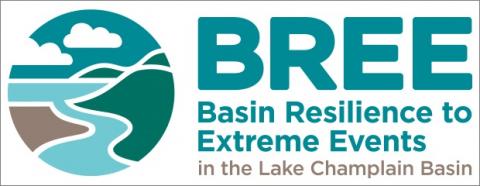
Vermont EPSCoR Wins $20 Million Award From National Science Foundation To Study and Promote Resiliency in Lake Champlain Basin 
Research Will Inform Public Policy, Support Economic and Workforce Development
What makes some parts of the Lake Champlain Basin and its watersheds resilient in the face of extreme weather events, increasingly common in a warming Vermont, while other parts fail to recover and rebound?
A $20 million award from the National Science Foundation to Vermont EPSCoR will help answer that question, providing much needed information to decision-makers as they govern the basin and develop policies that reach far into the future.
The award, one of the largest in Vermont history, was announced by U.S. Senator Patrick Leahy and University of Vermont president Tom Sullivan at press conference at the ECHO Leahy Center for Lake Champlain on April 18.
The five-year project will support research teams from UVM and colleges across the state that will collect data from sensors in streams, soil, and the lake and gather information on adjacent land use – by farms or developers, for instance.
A computer model will then be created integrating all three information sources. The model will be used to test management scenarios and identify strategies for preserving infrastructure, environmental health and drinking water quality in the event of intense storms.
“We’ll essentially be giving managers a tool that will help them build resiliency in areas that have been vulnerable in the past,” said Judith Van Houten, University Distinguished Professor at the University of Vermont, who is directing the research effort.
A diverse team of partners; combining natural and social sciences
The project will be undertaken by a diverse group of scientists and stakeholders working together with Vermont EPSCoR. In addition to UVM, other partner institutions include Johnson State College, Lyndon State College, Castleton State College, Middlebury College, Saint Michael’s College, Dartmouth College and the Community College of Vermont. Also participating in the project will be key stakeholders, including the Lake Champlain Basin Program and the Vermont Agency of Natural Resources and partners from Quebec and Lake George, NY.
NSF made the award to Vermont EPSCoR partly because both natural and social scientists working on the project will utilize complex systems approaches in creating their predictive models.
An earlier NSF award to Vermont EPSCoR, utilizing the same approach, provided insights into sources of phosphorus and nitrogen in the Lake Champlain basin and how these elements feed algal blooms. The work also identified a dominant role for extreme events in determining water quality in the Basin, providing a strong foundation for the current project’s focus on resiliency.
“I congratulate Vermont EPSCoR and the Vermont Technology Council for securing this federal grant to provide our state’s research community with the tools they need to explore both the science and affects of extreme weather events,” Senator Leahy said. “This research will support valuable new STEM learning opportunities for all students, including high school, undergraduate, graduate and post-doctoral researchers right here in Vermont. We are fortunate for this opportunity to build on our commitment to developing stronger, more resilient communities, while protecting our treasured Lake Champlain.”
“We are so fortunate to have the Basin as a living laboratory to examine, first hand, the many critical components that must be considered when tackling such large questions,” said UVM president Thomas Sullivan. “Our ability to have such an interdisciplinary team of researchers, post-doctoral associates, graduate students and undergraduates working together at UVM and with our partner institutions, embedded in this Basin, is another example of the incredible value the research has for all of Vermont and beyond.”
“VT EPSCoR is matched by none in terms of their track record for success as a state-wide federally funded program in Vermont,” said John Evans, president of the Vermont Technology Council, the statewide board for EPSCoR. “They have enabled multiple partnerships throughout the state in building research infrastructure, workforce size and diversity, and private sector competitiveness. You will see around you the evidence of their work with undergraduates, high schools and small businesses who are presenting their Vermont EPSCoR sponsored research today.”
“The merit review of the proposal for this new award is a true testament to the high caliber of research and innovation being conducted here by many talented researchers, and the relevance this research has not only to Vermont, but also to the region and beyond,” said Van Houten.
Workforce development a key part of award
A key element of the award will be the work performed by the Vermont EPSCoR Center for Workforce Development and Diversity at Saint Michael’s College (CWDD), which will offer research opportunities to Vermont high schools, middle schools and undergraduates from across Vermont, including a new partnership with Landmark College. Scholarships will be available to Abenaki students, first-generation college students, students with disabilities and veterans who are seeking science, technology, engineering or mathematics (STEM) majors. Girls will be supported through the Vermont Works for Women, Rosie’s Girls Program. Small businesses will also be able to participate through internships and funding from the Small Business Innovation Research Phase (0) program and support through Innovate HERS and Launch VT.
EPSCoR, the Experimental Program to Stimulate Competitive Research, is a program designed to fulfill the National Science Foundation's mandate to promote scientific progress nationwide. Through the program, NSF establishes partnerships with government, higher education and industry that are designed to effect lasting improvements in a state's or region's research infrastructure, R&D capacity and hence, its national R&D competitiveness.
Photos and links to other articles about this BREE can be found at:
http://epscor.w3.uvm.edu/2/node/3123
|

